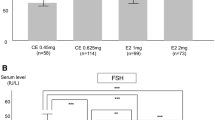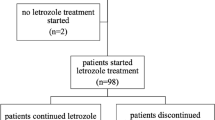Summary
Biochemical parameters reflecting bone resorption [urinary calcium/creatinine (Ca/Cr) and hydroxyproline/ creatinine (OH/Cr)] were related to serum estrogens [estrone (E1) and estradiol (E2)] in 262 healthy women including 158 patients receiving estrogen replacement therapy (ERT) for at least 6 months, 49 eugonadal women, and 55 untreated postmenopausal women. A significant (P<0.001) correlation exists between serum E2 and Ca/Cr: Ca/Cr (mg/dl)=-0.00044 E2 (pg/ml)+0.129 (n=262; r=-0.37), serum E2 and OH/Cr: (OH/Cr (mg/g)=-0.049 E2 (pg/ml)+18.76 (n=262; r=-0.36), serum E1 and Ca/Cr: Ca/Cr (mg/dl)=-0.0003 E1 (pg/ml)+0.127 (n=261; r=-0.28) but not between serum E1 and OH/Cr. Women with circulating levels of E2 between 60 and 90 pg/ml have a significant (P< 0.01) reduction of Ca/Cr and OH/Cr when compared with those with lower levels of E2. Higher values of E2 do not provide additional benefit. We conclude that in postmenopausal women receiving an estrogen replacement therapy (ERT), a significant reduction of bone resorption is achieved when circulating levels of estradiol reach a value (60 pg/ml) corresponding to the one measured, in eugonadal women, during the last days of the early follicular phase of the menstrual cycle. We suggest that oral or percutaneous ERT should induce a minimal value of 60 pg/ml to prevent postmenopausal bone loss.
Similar content being viewed by others
References
Christiansen C, Lindsay R (1991) Estrogens, bone loss and preservation. Osteoporosis Int 1:7–14
Bush TL (1991) Extraskeletal effects of estrogen and the prevention of atherosclerosis. Osteoporosis Int 2:5–11
Horsman A, Gallagher JC, Simpson M, Nordin BEC (1977) Prospective trial of oestrogen and calcium in postmenopausal women. Br Med J 2:789–792
Lindsay RD, Hart DM, Attken JM, Mac Donald EB, Anderson JB, Clark AC (1976) Long-term prevention of postmenopausal osteoporosis by oestrogen. Lancet i:1038–1071
Lindsay RD, Hart DM, Forrest C, Baird D (1980) Prevention of spinal osteoporosis in oophorectomized women. Lancet ii: 1151–1153
Nachtigall LE, Nachtigall RH, Nachtigall RD, Beckman EM (1979) Estrogen replacement therapy I: a 10-year prospective study in relationships to osteoporosis. Obstet Gynecol 53:277–281
Kreiger N, Kelsey JL, Holford TR (1982) An epidemiological study of hip fracture in postmenopausal women. Am J Epidemiol 11:141–148
Lindsay RD, Hart DM, MacLean A, Garwood J, Clark AC, Kraszewski A (1979) Bone loss during oestriol therapy in postmenopausal women. Maturitas 1:279–285
Lindsay R, Hart DM, Clark DM (1984) The minimum effective dose of estrogen for prevention of postmenopausal bone loss. Obstet Gynecol 63:759–763
Huppert LC (1987) Hormonal replacement therapy: benefits, risks, doses. Med Clin N Am 71:23–29
Walsh BW, Schiff I, Rosner B, Greenberg L, Ravnikar V, Sacks FM (1991) Effects of postmenopausal estrogen replacement on the concentrations and metabolism of plasma lipoproteins. N Engl J Med 325:1196–1204
Quigley ME, Martin PL, Burnier AM, Brooks P (1987) Estrogen therapy arrests bone loss in elderly women. Am J Obstet Gynecol 156:1516–1523
Young MM, Nordin BEC (1967) Effects of natural and artificial menopause on plasma and urinary calcium and phosphorus. Lancet ii:118–120
Christiansen C, Christensen MS, Larsen N, Transbol IB (1982) Pathophysiological mechanisms of estrogen effect on bone metabolism. Dose-response relationships in early postmenopausal women. J. Clin Endocrinol Metab 55:1124–1130
Uebelhart D, Schlemmer A, Johansen JS, Gineyts A, Christiansen C, Delmas PD (1991) Effect of menopause and hormone replacement therapy on the urinary excretion of pyridinium cross-links. J Clin Endocrinol Metab 72:367–373
Wimalawansa SJ, Kehely A, Banks LM, Stevenson JC, Endacott J, Whitehead M, MacIntyre I (1987) The effects of percutaneous oestradiol and low dose human calcitonin in postmenopausal bone loss. In: Christiansen C, Johansen JS, Riis BJ (eds) Osteoporosis 1987. Osteopress ApS Publishers, Copenhagen, pp 528–532
Ribot C, Tremollieres F, Pouilles JM, Louvet JP, Peyron R (1989) Preventive effects of transdermal administration of 17 beta estradiol on postmenopausal bone loss: a 2-year prospective study. Gynecol Endocrinol 3:259–268
Abraham GE (1977) Normal menstrual cycle. In: Givens JR (ed) Endocrine causes of menstrual disorders. Year Book Medical Publishers, Chicago, pp 15–44
Nordin BEC (1978) Diagnostic procedure in disorders of calcium metabolism. Clin Endocrinol 8:55–67
Morris HA, Wishart JM, Horowitz H, Need AG, Nordin BEC (1990) The reproducibility of bone-related biochemical variables in postmenopausal women. Ann Clin Biochem 27:562–568
Johansen JS, Riis BJ, Delmas PD, Christiansen C (1988) Plasma BGP: an indicator of spontaneous bone loss and of the effect of oestrogen treatment in postmenopausal women. Eur J Clin Invest 18:191–195
Slemenda C, Hui SL, Longcope C, Johnston CC (1987) Sex steroids and bone mass: a study of changes about the time of menopause. J Clin Invest 80:1261–1269
Riis BJ, Thomsen K, Storm V, Christiansen C (1987) The effect of percutaneous estradiol and natural progesterone on postmenopausal bone loss. Am J Obstet 156:61–65
MacIntyre I, Stevenson JC, Whitehead MI, Wimalawansa SJ, Banks LM, Healy MJR (1988) Calcitonin for prevention of postmenopausal bone loss. Lancet i:900–902
Scott RT, Ross B, Anderson C, Archer DF (1991) Pharmacokinetics of percutaneous estradiol: a crossover study using a percutaneous and a transdermal system in comparison with oral micronized estradiol. Obstet Gynecol 77:758–764
Ouyang PC, Chow SN, Huang SC, Hsieh CY (1986) Effect of estrogen replacement therapy on serum level of total estrogen and urinary excretion of calcium and hydroxyproline in postmenopausal Chinese women. Proc Natl Sci Counc B (ROC) 10:162–166
Stevenson JC, Cust MP, Gangar KF, Hillard TC, Lees B, Whitehead MI (1990) Effects of transdermal versus oral hormone replacement therapy on bone density in spine and proximal femur in postmenopausal women. Lancet ii:265–269
Varma TR, Everard D, Hole D (1985) Effect of natural estrogen on the serum level of follicle-stimulating hormone (FSH), estradiol, estrone in postmenopausal women and effects on endometrium. Acta Obstet Gynecol Scand 64:105–109
Author information
Authors and Affiliations
Rights and permissions
About this article
Cite this article
Reginster, J.Y., Sarlet, N., Deroisy, R. et al. Minimal levels of serum estradiol prevent postmenopausal bone loss. Calcif Tissue Int 51, 340–343 (1992). https://doi.org/10.1007/BF00316876
Received:
Revised:
Issue Date:
DOI: https://doi.org/10.1007/BF00316876




